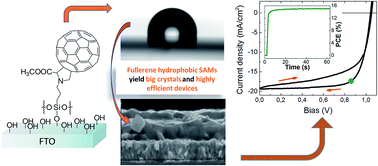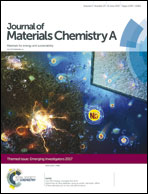Functionalization of transparent conductive oxide electrode for TiO2-free perovskite solar cells†
Abstract
Many of the best performing solar cells based on perovskite-halide light absorbers use TiO2 as an electron selective contact layer. However, TiO2 usually requires high temperature sintering, is related to electrical instabilities in perovskite solar cells, and causes cell performance degradation under full solar spectrum illumination. Here we demonstrate an alternative approach based on the modification of transparent conductive oxide electrodes with self-assembled siloxane-functionalized fullerene molecules, eliminating TiO2 or any other additional electron transporting layer. We demonstrate that these molecules spontaneously form a homogenous monolayer acting as an electron selective layer on top of the fluorine doped tin oxide (FTO) electrode, minimizing material consumption. We find that the fullerene-modified FTO is a robust, chemically inert charge selective contact for perovskite based solar cells, which can reach 15% of stabilised power conversion efficiency in a flat junction device architecture using a scalable, low temperature, and reliable process. In contrast to TiO2, devices employing a molecularly thin functionalized fullerene layer show unaffected performance after 67 h of UV light exposure.

- This article is part of the themed collection: Journal of Materials Chemistry A Emerging Investigators


 Please wait while we load your content...
Please wait while we load your content...